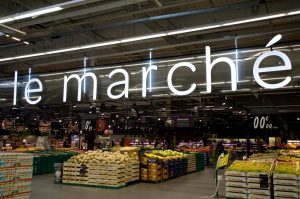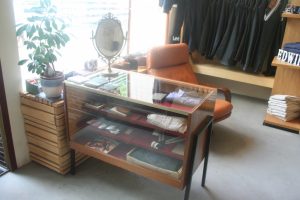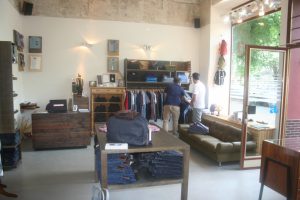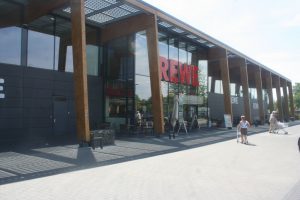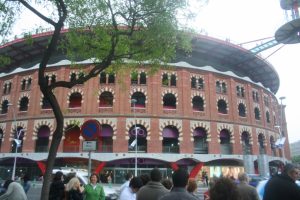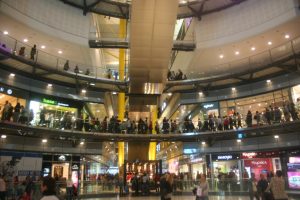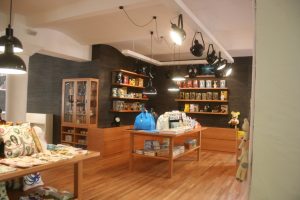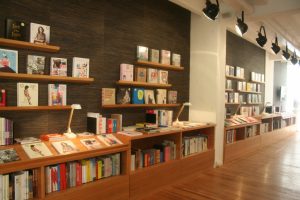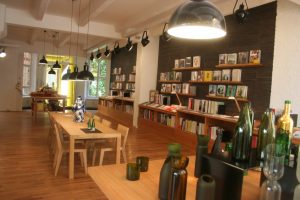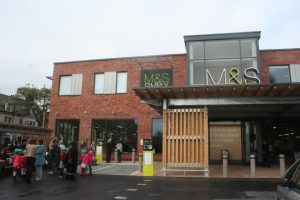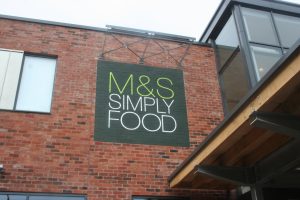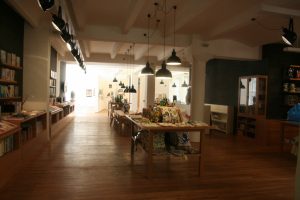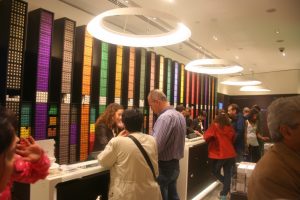Generalization is dangerous, but there are a number of Pan-European trends that have emerged over the last year that show the Old World is still capable of unveiling new thinking.
The new, good-looking, green
Certainly, green has shifted from a marketing tool deployed to win favor with responsibly minded shoppers to something taken for granted by consumers – and now is an important design tool that also looks good.
Today’s retailers seem determined to ensure they not only do their part to curb emissions and slow down their use of resources, but that they also provide shoppers with environments that appeal on an aesthetic level.
This new green wave can be seen in Marks & Spencer’s Simply Food store in Sheffield, in the north of England. Opened in April, this store has an abundance of ecologically benign features, ranging from the use of interior LED lights and a perimeter clad with sustainable birch wood panels to a digital arrivals board behind the checkouts to inform shoppers who use public transport when the next bus will arrive.
M&S reclaimed bricks from a vacant 19th Century mill for much of the structure and then clad one of the external walls with a vertical garden. This may be familiar to Anthropologie fans, but it’s a first in Europe for a supermarket.
Advertisement
Something similar can be seen in Berlin, where German food retailer Rewe opened a new store last year that flaunts its eco-credentials as well as serves as an architectural tour de force. First, there’s the wooden canopy on the outside, providing shade for large plate-glass windows while allowing high levels of natural daylight to flood the interior. Add a lighting system that’s attractive and low-energy and this is new green writ large.
Good-looking green can also be seen in Carrefour’s two Planet stores in Lyons, France, which opened last year. Here, two large, single-floor food and general merchandise stores are greener than other parts of the French hypermarket operator’s store estate with lower ambient lighting levels, skylights and digital shelf-edge signage, which helps reduce the use of cardboard p-o-s material. The new green spaces are organized into “worlds,” such as “marché,” “maison” and “le bio” (organic food), using large overhead beacons dramatically set into a blacked-out ceiling void. Reduced light levels in the market area mean the lighting is aimed on the product rather than the overall interior, creating dramatic light-and-shade areas, while at the same time cutting down on energy usage.
Rough-luxe
The rough-and-ready ethos characterized by pop-up stores for the past couple of years is fast becoming a trend in its own right with the arrival of permanent rough-luxe stores. In Europe, this look, found in back-to-basics plain walls, vintage furniture and deliberately distressed interiors, has found its spiritual home in Berlin.
Cultural store Gestalten Verlag is a prime example. Located in a striking brick-built 19th Century structure on the east side of the German capital, Verlag is the retail manifestation of an art book publisher. Open since May, it’s where gallery-meets-bookshop-meets-installation space, all within an industrial white interior that was formerly a bicycle chain factory. Things have been freshened up with simple modern display tables in the mid-shop and stripped wooden planks for the floor, while the concrete columns and exposed ceiling joists work with the factory-style pendant lights to maintain the original ambiance.
Across the city, men’s jeans and casualwear store Akeef, located in the counter-culture Kreuzberg district, is another prime example of rough-luxe fashion retailing. This is a small shop with a traditional boxed-window exterior that, from a distance, looks a little rundown. Inside, secondhand furniture, including vintage 1960s pieces, plain painted walls and exposed concrete are combined with a basement, accessed by a trapdoor, where music events can be staged.
Advertisement
In London, the new Oliver Spencer shoe shop and Mary’s Living & Giving shop, a charity store created by TV personality Mary Portas, also stand as examples of this trend.
For many brands, ostentatious luxury environments do not chime with the times, but selling luxury merchandise in rough-luxe settings is sure to please.
Reuse, repurpose, recycle
A third major trend in Europe – and something that also resonates with the popularity of green and rough-luxe – is the idea of giving existing structures new life as retail environments. Economically, the past three years could not be described as buoyant (which may account for this trend taking hold) and repurposing a large building can’t be considered the lowest-cost options. But as more commercial and public buildings become vacant, the ability to find viable store locations is becoming easier.
One of the best examples continent-wide is found in Barcelona, Spain. Here, Las Arenas, a former bullring, has been turned into a shopping center, which opened in April. Designed by “starchitect” Richard Rogers, this forum is now a three-story shopping center where retailers, including a flagship from upscale coffee purveyor Nespresso and fashion stores from Mango, Desigual and Yamamay, have put their best feet forward.
From the outside, the historic structure maintains the appearance of a large bullring. Inside, more than 100 retailers are housed in shops arranged around the perimeter, preserving the sense of a ring. The uppermost level is devoted to leisure, including a multiplex cinema. Banks of escalators at the heart of this shopping center give shoppers views through the entire space.
Advertisement
The same trend can be observed in London with the refurbishment of the St. Pancras rail terminal and the creation of a mall that forms the pre-departure area for Paris-bound Eurostar travelers. Here, the 19th Century brick arches have been turned into retail spaces occupied by names such as bookstore Foyles, Belgian chocolate brand Neuhaus and, most recently, household gifts retailer Cath Kidston.
The remodeling of the Citadium store in Paris by its department store owner Printemps is also an example of remodeling old buildings instead of building new. This multi-level piece of 1980s modernism, which had been allowed to fall on hard times, was refurbished in 2010 and has emerged as a standard-bearer for young fashion with its rounded-glass bull-nose entrance and circular floors within.
These are just some of the trends that have appeared over the last year in European store design. And in spite of press reports that retailers across the continent have been hunkering down and waiting for the market to improve, these projects show signs of life and novelty appearing in the retail pipeline.
For more on these trends and the latest design projects in Europe, catch John Ryan’s session, “European Retail: In With the New,” at VMSD’s International Retail Design Conference, Sept. 7-9 in San Francisco. For details, visit www.irdconline.com.


 Photo Gallery1 week ago
Photo Gallery1 week ago
 Headlines7 days ago
Headlines7 days ago
 Headlines1 week ago
Headlines1 week ago
 Headlines2 weeks ago
Headlines2 weeks ago
 Headlines1 week ago
Headlines1 week ago
 Designer Dozen2 weeks ago
Designer Dozen2 weeks ago
 Designer Dozen5 days ago
Designer Dozen5 days ago
 Headlines7 days ago
Headlines7 days ago

